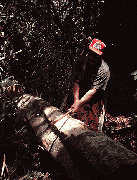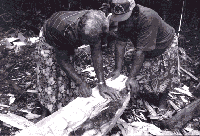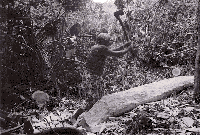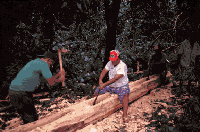Rough Carving
 In the process of falling the
tree, it was discovered that there was some rot in its base. Once
the tree was felled, the end was systematically trimmed with a
chainsaw until the area of dryrot was removed. This process shortened
the log by five feet. On the ground the butt end of the tree was
downhill. Shortly after the falling, a liquid began to trickle
from the cut end. Boaz drank some of this liquid and some of the
other carvers tasted it. After watching this, I also sampled the
lifeblood of the tree; it had a sweet taste.
In the process of falling the
tree, it was discovered that there was some rot in its base. Once
the tree was felled, the end was systematically trimmed with a
chainsaw until the area of dryrot was removed. This process shortened
the log by five feet. On the ground the butt end of the tree was
downhill. Shortly after the falling, a liquid began to trickle
from the cut end. Boaz drank some of this liquid and some of the
other carvers tasted it. After watching this, I also sampled the
lifeblood of the tree; it had a sweet taste.
With the end of the tree free of rot, a measure stick was made
of roughly six feet (one fathom). This distance was found by the
distance of one's stretched arms fingertip to fingertip; one loho.
|
(loho. Unit of Measure: fathom (span of the outstretched
arms); to measure by fathoms. (Kapingamarangi Lexicon: Lieber
and Dikepa. 1974) |
The loho stick was then used to locate the other cut
point (the length the log that was to be cut). The distance used
was three and one-half loho. A mark was made and the log
was cut. Again the chainsaw was used, at this point fixing the
length of the dugout. The cut log measured at almost 22 feet.
It was my understanding that the boat was to be longer but perhaps
due to the rot, the length was shortened. Some rough carving at
the butt end was started. Information in Material Cultures
of Kapingamarangi indicates that the base of the tree was
usually oriented as the bow of the canoe.
|
"At the same time, men were narrowing the ends to form the
bow and the stern, with the bow, as always, at the butt end of
the log." (Buck, 1950. P. 176) |
Later, interviews with master canoe carvers Yoni and Noah on
Kapingamarangi confirmed the information in Material Culture
of Kapingamarangi. When asked what might be the reason for
having the butt end of the tree as the bow they said it was probably
because the wood at that end of the tree was stronger.
With the tree on the ground a rest
was called. Aisea seemed interested in continuing and so he did.
The branches were trimmed off and the shaping of the ends was
continued. The process of roughing the hull continued while the
primary undertaking was moving the log.
 The
moving was accomplished through the use of small log skids, a
heavy-duty jack and a come-a-long. This process took about thirty
minutes. This work, as with the rest of what I had witnessed,
moved along at a steady, though relaxed rate. As some men tired
others who had been resting took their place. The carving continued
throughout the moving. The log was eventually pulled up to a flat,
shady area. It was lifted up off the ground about ten inches and
placed on logs.
The
moving was accomplished through the use of small log skids, a
heavy-duty jack and a come-a-long. This process took about thirty
minutes. This work, as with the rest of what I had witnessed,
moved along at a steady, though relaxed rate. As some men tired
others who had been resting took their place. The carving continued
throughout the moving. The log was eventually pulled up to a flat,
shady area. It was lifted up off the ground about ten inches and
placed on logs.
Roughing out the form of the canoe (at least on the exterior)
was done by a series of curf cuts (cuts made across the grain
spaced about a foot apart), and then smoothing cuts (glancing
axe blows that removed the wood in between the curf cuts). The
axes were of the normal type, not broad axes. When a minimum amount
of wood needed removing, the curf cut was not used. Once a rough
shape was achieved for the underbody, the log was righted and
the flattening of the top commenced. Again, the men took turns
working as each person tired. Although there was some trouble
with the chainsaw, it was still used at times. Most of the work
was done with axes up to this point.
A tool change occurred once the top of the hull was roughed
flat. Instead of axes, adzes were used as they refined the smoothing
process. This took about thirty minutes.
 With
the hull upright and flattened, Aisea turned his attention to
cutting a "d" size battery open with his machete. I
had no idea what he was doing and thought it had nothing to do
with the construction. Once he had the battery open, he emptied
out a black charcoal-like powder onto a jar lid. The term "chalk
line" was mentioned. Water was added to this black powder
and mixed up. A string was then drawn through the paste and made
ready for marking the hull. Two lines were marked on the topside
of the hull. They were running fore and aft about seven inches
apart. The space between these lines was to be removed. This removal
was done in two ways; the first was the traditional manner.
With
the hull upright and flattened, Aisea turned his attention to
cutting a "d" size battery open with his machete. I
had no idea what he was doing and thought it had nothing to do
with the construction. Once he had the battery open, he emptied
out a black charcoal-like powder onto a jar lid. The term "chalk
line" was mentioned. Water was added to this black powder
and mixed up. A string was then drawn through the paste and made
ready for marking the hull. Two lines were marked on the topside
of the hull. They were running fore and aft about seven inches
apart. The space between these lines was to be removed. This removal
was done in two ways; the first was the traditional manner.
 Aisea,
using an axe, alternated between diagonal cuts and then for wood
removal his axe landed parallel with the grain and split out the
remaining wood. The other method used the chainsaw. Long cuts
were made along the layout lines and then cross cuts were made
at a spacing of about ten inches. The in-fill wood was then removed
by either an adze or wedge.
Aisea,
using an axe, alternated between diagonal cuts and then for wood
removal his axe landed parallel with the grain and split out the
remaining wood. The other method used the chainsaw. Long cuts
were made along the layout lines and then cross cuts were made
at a spacing of about ten inches. The in-fill wood was then removed
by either an adze or wedge.
Into the second day of roughing
out the canoe more rotted wood was discovered. Eventually it was
determined that the log was unsuitable for the canoe main hull.
The log was cut in half and then shaped into the rough form of
the fore and aft momos, the washboards, stem and stern
of the canoe. What lumber that could be salvaged was re-sawn and
stacked for drying. A new tree was needed. We packed up the tools
and drove back to town.
 The
next tree was found on the opposite side of the island. This time
it was on property owned by someone from Kapingamarangi. Kosen
owned land not far from where the second tree was found. The same
process as described earlier also occurred with the second tree.
Work moved much faster, as the practice of the first tree allowed
for a more organized approach. After a few days of steady work
the roughed out hull was covered with leaves to protect it from
the sun and left to dry. This usually took a month or more but
for this project it was decided that a week was sufficient.
The
next tree was found on the opposite side of the island. This time
it was on property owned by someone from Kapingamarangi. Kosen
owned land not far from where the second tree was found. The same
process as described earlier also occurred with the second tree.
Work moved much faster, as the practice of the first tree allowed
for a more organized approach. After a few days of steady work
the roughed out hull was covered with leaves to protect it from
the sun and left to dry. This usually took a month or more but
for this project it was decided that a week was sufficient.
An excellent description of rough carving a canoe can be found
in Material Culture of Kapingamarangi by Buck, (1950) pages
175-179. The report describes the shaping of a canoe in 1949 on
the Kapingamarangi atoll. Forty-seven years later, what I observed
closely followed the methods described in his report.(See Appendix I, pp.175-179)
 In the process of falling the
tree, it was discovered that there was some rot in its base. Once
the tree was felled, the end was systematically trimmed with a
chainsaw until the area of dryrot was removed. This process shortened
the log by five feet. On the ground the butt end of the tree was
downhill. Shortly after the falling, a liquid began to trickle
from the cut end. Boaz drank some of this liquid and some of the
other carvers tasted it. After watching this, I also sampled the
lifeblood of the tree; it had a sweet taste.
In the process of falling the
tree, it was discovered that there was some rot in its base. Once
the tree was felled, the end was systematically trimmed with a
chainsaw until the area of dryrot was removed. This process shortened
the log by five feet. On the ground the butt end of the tree was
downhill. Shortly after the falling, a liquid began to trickle
from the cut end. Boaz drank some of this liquid and some of the
other carvers tasted it. After watching this, I also sampled the
lifeblood of the tree; it had a sweet taste.
